Warning: pic heavy, as usual. 

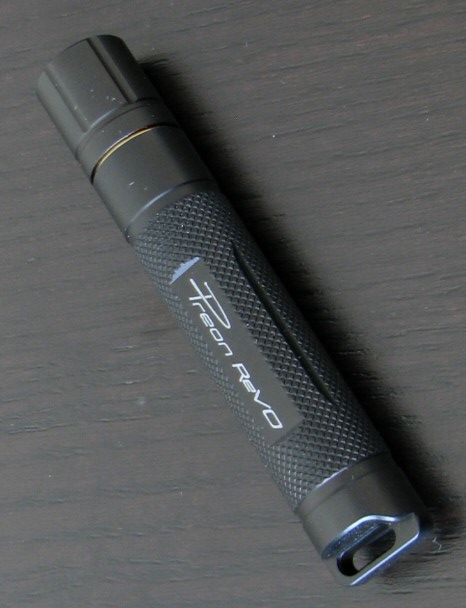
Specifications:

The light comes in fairly typical 4Sevens packaging. Inside the thin cardboard case with plastic insert is the light, spare o-ring, small split-ring, Duracell AAA battery, manual and warranty card.

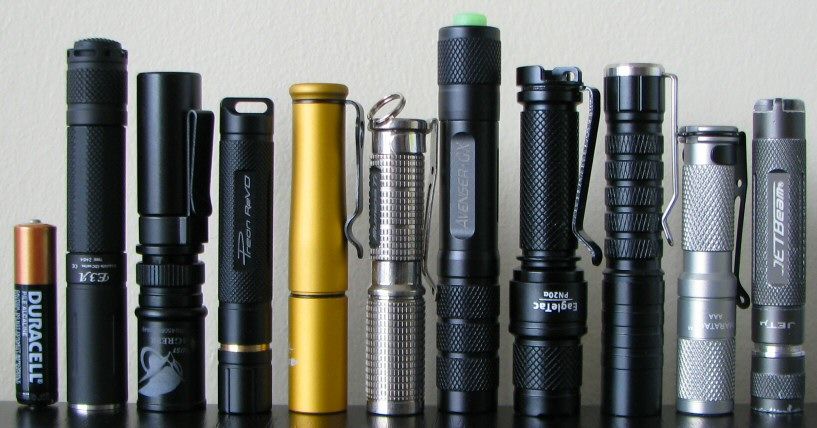
From left to right: Duracell alkaline AAA, Tiablo E3A, 4GREER WS1, 4Sevens ReVo, Preon 1, Titanium Innovations LuminaTi, Lumapower Avenger GX, Eagletac PN20α, LiteFlux LF2XT, Maratac AAA, JetBeam Jet-u.
4GREER WS1: Weight: 25.2g , Length 79.3mm x Width 16.2mm (bezel)
4Sevens Preon 1: Weight 15.3g (with keychain clip), Length 75.6mm x Width 14.0mm (bezel)
4Sevens Preon ReVo:: Weight: 11.3g , Length 72.7mm (battery installed) x Width 12.9mm
ITP EOS A3 Upgraded: Weight: 11.6g (no clip), Length: 69.7 x Width 14.1mm (bezel)
ITP H01: Weight: 22.7g, Length 53.7mm x Width 37.2 (max body) or 15.4mm (bezel)
EagleTac PN20α: Weight 22.9g (with pocket clip), Length 80.1mm x Width 16.0mm (bezel), 18.6mm (max, around base)
LiteFlux LF2XT: Weight: 21.2g (with pocket clip). Length 81.2mm x Width 14.9mm (bezel widest portion)
Lumapower Avenger GX: Weight: 22.9g (with Clicky switch), 22.0g (with twisty switch), Length 93.8mm (with clicky switch) or 86.7mm (with twisty switch) x Width 15.2mm (bezel widest portion)
Maratac 1xAAA: Weight: 10.9g , Length: 67.5mm x Width: 14.1mm (bezel)
Tiablo E3A: Weight: 18.3g, Length 87.5mm x Width 14.8mm (bezel)
Titanium Innovations IlluminaTi: Weight 23.5g (with keychain clip), Length 68.8mm x Width 14.0mm (bezel)
VersaTi: Weight: 23.2g (no clip), Length: 67.1mm, Width: 14.6mm
The ReVO is one of the smallest 1xAAA lights I've seen. oo: Style is reminiscent of the old JetBeam Jet-u.
oo: Style is reminiscent of the old JetBeam Jet-u.


In keeping with its twisty status, screw threads are anodized for lock-out (i.e. tighten to turn on).
Light can tailstand (barely ).
).
Lettering is sharp and clear, in a muted gray-white against the black matte finish (type III hard anodizing). No chips or flaws on my sample. There is some reasonably good knurling on the body, and some fluted ridges on the head, to help with grip. Light can be operated one-handed.

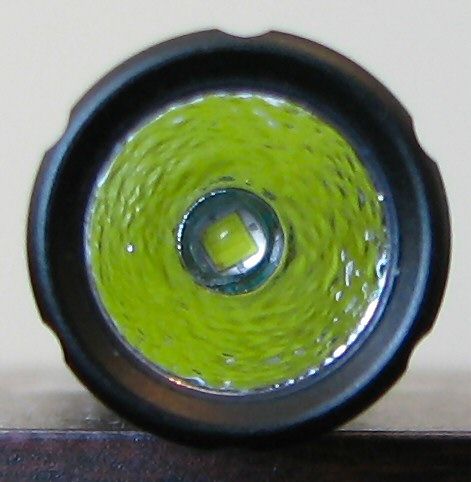
4Sevens went with the XP-E emitter (R2 output bin) for this light, in a fairly deep OP reflector. I think this was a good call (scroll down to the end for a discussion)
And now for the requisite white wall hunting . All lights are on Hi on Sanyo Eneloop AAA, about ~0.5 meter from a white wall.
. All lights are on Hi on Sanyo Eneloop AAA, about ~0.5 meter from a white wall.
Sorry for the quality of the white wall beamshots – I've recently moved, and haven't had a chance to set up a proper beamshot closet yet. What you are looking at below is recently primed drywall.




As you can see, the ReVO has a more "typical" beam profile for a 1xAAA light (i.e. not as wide a spillbeam as the Preon 1). The hotspot is broad and diffuse, with a smooth transition from spot to spill.
User Interface
Turn on the ReVO by fully tightening the bezel. The light is off when the bezel is loosened.
Light comes on in Lo output to start. To select a different level, turn the ReVO off and then back on again within 1 second. This will advance to the next level of constant output in the following sequence: Lo -> Med -> Hi.
If the light is left off for ~2 secs or longer, it will revert back to Lo.
Like the others in the Preon series, the ReVO has 3 special output modes (Strobe, SOS, and Beacon). To access these modes, ensure the ReVO has been off for at least 2 seconds, then quickly switch through two full 'cycles' of the regular outputs. The two full cycles must be completed within 2 seconds, as follows:
Low -> Medium -> High -> Low -> Medium -> High -> Special Outputs
Once in the Special Outputs, you cycle through them with the regular twist off-on in the following sequence:
Strobe -> S.O.S. -> Beacon
After Beacon mode, the output automatically reverts back to regular Lo. You would need to the 7-twist switching to get back to Strobe.
Note that the SOS and Beacon modes are a little unusual. The SOS keeps the light on in Lo at all times, and "jumps" up in output to Max for the flashes. The Beacon mode flashes 5 times in increasing output, then stays in constant output on Lo with a single flash every 10 secs.
Note also that the ReVO has a "smart" Hi mode that steps down ~20% in output after a few minutes (to extend runtime).
PWM and Strobe
I couldn't detect any signs of PWM on the Lo/Med modes.

Strobe freq measured at 8.8 Hz.
Testing Method: All my output numbers are relative for my home-made light box setup, a la Quickbeam's flashlightreviews.com method. You can directly compare all my relative output values from different reviews - i.e. an output value of "10" in one graph is the same as "10" in another. All runtimes are done under a cooling fan, except for the extended run Lo/Min modes (i.e. >12 hours) which are done without cooling.
Throw values are the square-root of lux measurements taken at 1 meter from the lens, using a light meter.
Throw/Output Summary Chart:


Output/Runtime Comparison:
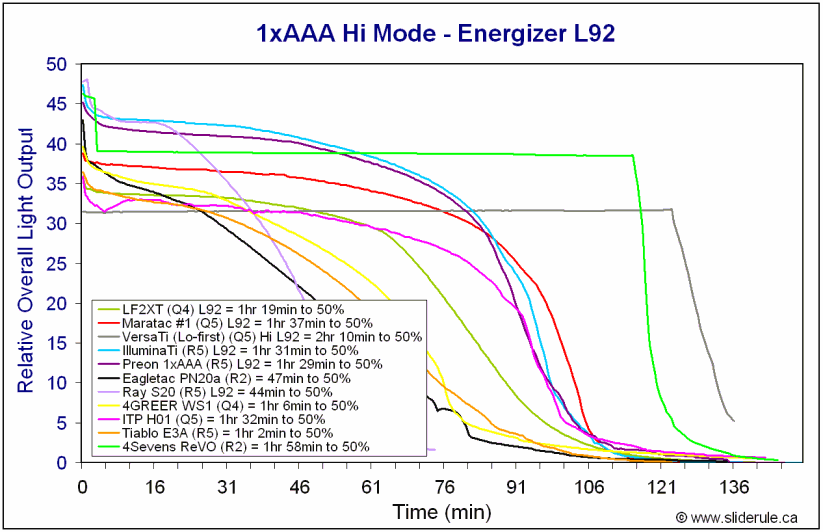
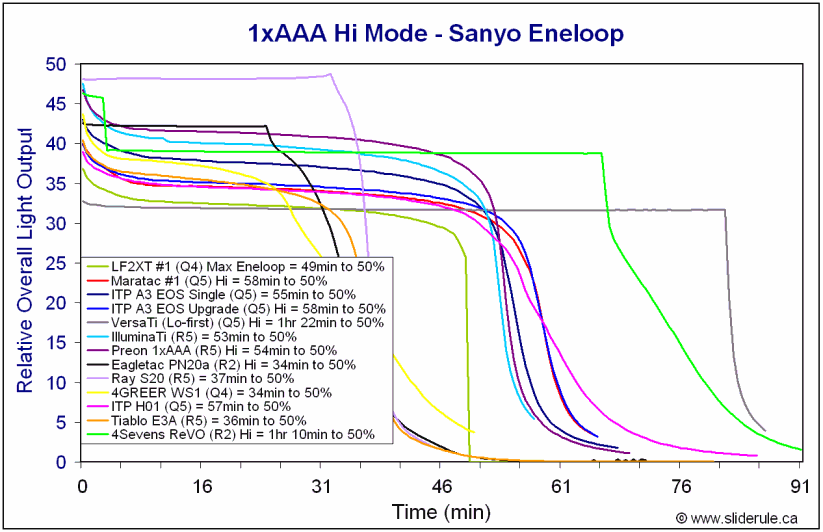



Note the step-down that occur ~3mins into the Hi runs.
Potential Issues
Head twist designs always have the potential to be "battery crushers." However, the ReVO seems to have some sort of flexible negative terminal pole. Not sure how it works, but I note that it rattles if you don't have a battery installed.
The time allowed for entering the Special modes is bit short (i.e. 2 secs for 7 On twists). Also, if you miss the mode you want, you have to start all over again, as you automatically exit back to regular modes after Beacon mode.
The SOS and beacon modes are unusual, with constant Lo output instead of shutting off between flashes.
Light cannot take 10440 Li-ion.
There is ~20% step-down in output that occurs ~3 mins into the Hi mode runs, as 4Sevens reports for this light.
Tailstanding is a bit iffy (i.e. wobbles easily).
Preliminary Observations
It seems clear to me that emitter output bin alone is a poor predictor of performance in the 1xAA class of lights – both for max output, and output/runtime efficiency. I've seen a number of XP-G R5-equipped lights that are no brighter than their earlier XR-E Q4/Q5 counterparts, and runtime efficiencies that are all over the map. Clearly, circuit design is pivotal in this class of flashlight – although I suspect other characteristics of the emitter (e.g. Vf) may also be critical.
The ReVO opts to use a XP-E with a R2 output bin – yet produces among the highest output and best overall output-runtime efficiency for this class of light. Well done!
The ReVO seems optimized for runtime performance – note the initial drop from Max output to ~80% after 3 mins. The light definitely seems to be current-controlled, given its excellent runtime performance and the lack of PWM. :thumbsup:
The build is excellent for this type of light – one of the smallest multi-mode 1xAAA light I've seen (just a hair under my old Jet-u in length and width). Mode switching is smooth, and I was able to do it one-handed (something I always found tricky with the regular Preons). And I like the look of the brass heatsink.
I also like the simple Lo – Med – Hi interface in regular mode (my preferred sequence). "Special" modes are well hidden. Actually, maybe a little too well hidden – I found it hard to consistently access Strobe. You need to do exactly 7 twists On in under 2 secs. :sweat: Miss your shot either way, over or under, and you have to start over (i.e. you can't cycle back to it in Special Output modes). That's a minor nitpick, since I can't see myself really using these too often, but I would think giving folks 3 or 4 secs would be better.
All said and done, this seems to be an excellent package for those looking for a miniscule 1xAAA for keychain carry.
----
ReVO was supplied by 4Sevens.com for review.


Specifications:
- LED: CREE XP-E R2 Emitter
- Six modes of output
- Low: 1.5 lumens, 2.8 days
- Medium: 19.8 lumens, 5.7 hours
- High: 82 lumens, 0.9 hours
- Strobe: 2.5 hours
- S.O.S.: 2 hours
- Beacon: 48 hours
- Dimensions: Length: 2.8 in, Diameter: 0.5 in, Weight: 0.46 oz
- Power: One AAA battery (included)
- Operating Voltage Range: 0.9V~1.5V
- Material: Type III, hard-anodized aircraft-grade aluminum
- Lens: Optical grade glass lens with anti-reflective coating
- Estimated MSRP ~$44

The light comes in fairly typical 4Sevens packaging. Inside the thin cardboard case with plastic insert is the light, spare o-ring, small split-ring, Duracell AAA battery, manual and warranty card.


From left to right: Duracell alkaline AAA, Tiablo E3A, 4GREER WS1, 4Sevens ReVo, Preon 1, Titanium Innovations LuminaTi, Lumapower Avenger GX, Eagletac PN20α, LiteFlux LF2XT, Maratac AAA, JetBeam Jet-u.
4GREER WS1: Weight: 25.2g , Length 79.3mm x Width 16.2mm (bezel)
4Sevens Preon 1: Weight 15.3g (with keychain clip), Length 75.6mm x Width 14.0mm (bezel)
4Sevens Preon ReVo:: Weight: 11.3g , Length 72.7mm (battery installed) x Width 12.9mm
ITP EOS A3 Upgraded: Weight: 11.6g (no clip), Length: 69.7 x Width 14.1mm (bezel)
ITP H01: Weight: 22.7g, Length 53.7mm x Width 37.2 (max body) or 15.4mm (bezel)
EagleTac PN20α: Weight 22.9g (with pocket clip), Length 80.1mm x Width 16.0mm (bezel), 18.6mm (max, around base)
LiteFlux LF2XT: Weight: 21.2g (with pocket clip). Length 81.2mm x Width 14.9mm (bezel widest portion)
Lumapower Avenger GX: Weight: 22.9g (with Clicky switch), 22.0g (with twisty switch), Length 93.8mm (with clicky switch) or 86.7mm (with twisty switch) x Width 15.2mm (bezel widest portion)
Maratac 1xAAA: Weight: 10.9g , Length: 67.5mm x Width: 14.1mm (bezel)
Tiablo E3A: Weight: 18.3g, Length 87.5mm x Width 14.8mm (bezel)
Titanium Innovations IlluminaTi: Weight 23.5g (with keychain clip), Length 68.8mm x Width 14.0mm (bezel)
VersaTi: Weight: 23.2g (no clip), Length: 67.1mm, Width: 14.6mm
The ReVO is one of the smallest 1xAAA lights I've seen.


In keeping with its twisty status, screw threads are anodized for lock-out (i.e. tighten to turn on).
Light can tailstand (barely
Lettering is sharp and clear, in a muted gray-white against the black matte finish (type III hard anodizing). No chips or flaws on my sample. There is some reasonably good knurling on the body, and some fluted ridges on the head, to help with grip. Light can be operated one-handed.


4Sevens went with the XP-E emitter (R2 output bin) for this light, in a fairly deep OP reflector. I think this was a good call (scroll down to the end for a discussion)
And now for the requisite white wall hunting
Sorry for the quality of the white wall beamshots – I've recently moved, and haven't had a chance to set up a proper beamshot closet yet. What you are looking at below is recently primed drywall.




As you can see, the ReVO has a more "typical" beam profile for a 1xAAA light (i.e. not as wide a spillbeam as the Preon 1). The hotspot is broad and diffuse, with a smooth transition from spot to spill.
User Interface
Turn on the ReVO by fully tightening the bezel. The light is off when the bezel is loosened.
Light comes on in Lo output to start. To select a different level, turn the ReVO off and then back on again within 1 second. This will advance to the next level of constant output in the following sequence: Lo -> Med -> Hi.
If the light is left off for ~2 secs or longer, it will revert back to Lo.
Like the others in the Preon series, the ReVO has 3 special output modes (Strobe, SOS, and Beacon). To access these modes, ensure the ReVO has been off for at least 2 seconds, then quickly switch through two full 'cycles' of the regular outputs. The two full cycles must be completed within 2 seconds, as follows:
Low -> Medium -> High -> Low -> Medium -> High -> Special Outputs
Once in the Special Outputs, you cycle through them with the regular twist off-on in the following sequence:
Strobe -> S.O.S. -> Beacon
After Beacon mode, the output automatically reverts back to regular Lo. You would need to the 7-twist switching to get back to Strobe.
Note that the SOS and Beacon modes are a little unusual. The SOS keeps the light on in Lo at all times, and "jumps" up in output to Max for the flashes. The Beacon mode flashes 5 times in increasing output, then stays in constant output on Lo with a single flash every 10 secs.
Note also that the ReVO has a "smart" Hi mode that steps down ~20% in output after a few minutes (to extend runtime).
PWM and Strobe
I couldn't detect any signs of PWM on the Lo/Med modes.

Strobe freq measured at 8.8 Hz.
Testing Method: All my output numbers are relative for my home-made light box setup, a la Quickbeam's flashlightreviews.com method. You can directly compare all my relative output values from different reviews - i.e. an output value of "10" in one graph is the same as "10" in another. All runtimes are done under a cooling fan, except for the extended run Lo/Min modes (i.e. >12 hours) which are done without cooling.
Throw values are the square-root of lux measurements taken at 1 meter from the lens, using a light meter.
Throw/Output Summary Chart:


Output/Runtime Comparison:





Note the step-down that occur ~3mins into the Hi runs.
Potential Issues
Head twist designs always have the potential to be "battery crushers." However, the ReVO seems to have some sort of flexible negative terminal pole. Not sure how it works, but I note that it rattles if you don't have a battery installed.
The time allowed for entering the Special modes is bit short (i.e. 2 secs for 7 On twists). Also, if you miss the mode you want, you have to start all over again, as you automatically exit back to regular modes after Beacon mode.
The SOS and beacon modes are unusual, with constant Lo output instead of shutting off between flashes.
Light cannot take 10440 Li-ion.
There is ~20% step-down in output that occurs ~3 mins into the Hi mode runs, as 4Sevens reports for this light.
Tailstanding is a bit iffy (i.e. wobbles easily).
Preliminary Observations
It seems clear to me that emitter output bin alone is a poor predictor of performance in the 1xAA class of lights – both for max output, and output/runtime efficiency. I've seen a number of XP-G R5-equipped lights that are no brighter than their earlier XR-E Q4/Q5 counterparts, and runtime efficiencies that are all over the map. Clearly, circuit design is pivotal in this class of flashlight – although I suspect other characteristics of the emitter (e.g. Vf) may also be critical.
The ReVO opts to use a XP-E with a R2 output bin – yet produces among the highest output and best overall output-runtime efficiency for this class of light. Well done!

The ReVO seems optimized for runtime performance – note the initial drop from Max output to ~80% after 3 mins. The light definitely seems to be current-controlled, given its excellent runtime performance and the lack of PWM. :thumbsup:
The build is excellent for this type of light – one of the smallest multi-mode 1xAAA light I've seen (just a hair under my old Jet-u in length and width). Mode switching is smooth, and I was able to do it one-handed (something I always found tricky with the regular Preons). And I like the look of the brass heatsink.
I also like the simple Lo – Med – Hi interface in regular mode (my preferred sequence). "Special" modes are well hidden. Actually, maybe a little too well hidden – I found it hard to consistently access Strobe. You need to do exactly 7 twists On in under 2 secs. :sweat: Miss your shot either way, over or under, and you have to start over (i.e. you can't cycle back to it in Special Output modes). That's a minor nitpick, since I can't see myself really using these too often, but I would think giving folks 3 or 4 secs would be better.
All said and done, this seems to be an excellent package for those looking for a miniscule 1xAAA for keychain carry.
----
ReVO was supplied by 4Sevens.com for review.
Last edited:



